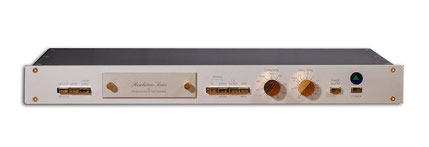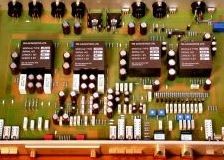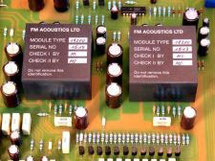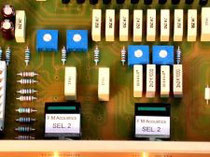Resolution Series 222-MKIII

The original FM 222 revolutionized the reproduction of vinyl records to a standard never imagined - and this in the days when a huge worldwide marketing campaign (and a bit of impaired logic by
press and some public alike...) hailed the CD as "perfect music forever"...
The FM 222 provided the big breakthrough for vinyl reproduction that hundredthousands of collectors and aficionados had been waiting for. With the singular features and circuits of the FM 222 it
was for the first time possible to realize what wealth of detail and information lay buried in record grooves. It truly is phenomenal what realism and incredible music reproduction can be
extracted from decent vinyl.
The FM 222 is T H E revelation. Quickly musicians, producers, engineers, libraries and collectors in many parts of the world realized that with the FM 222 a new era was dawning:
A total re-vitalization of record reproduction was finally possible.
A short demonstration convinced even the most sceptical engineers and listeners.
The rest is history: the FM 222 - manufactured continuously since 1992 - has become a tremendous success.
More orders than ever poured in when the "MKII" version was introduced 7 years ago. Carefully perfected, it provides a performance so far ahead that no one else even tried to challenge it. Never
has there been anything comparable.
Recently, new parts have become available that - together with advanced insights due to continuous research - allow further ameliorations. The refinements manifest themselves in some smaller
modifications but also some more substantial improvements.
It is a pleasure indeed to announce the "MK-III" version of the FM 222. Of course, all the original features have been kept and some new ones added. Everything has been carefully optimized.
For the true balanced outputs FM ACOUSTICS new proprietary "HR" type 19200 modules are employed. These new HR modules are the result of a research-intensive multi-year development. They achieve a
superb level of reproduction and reliability. Never before has such a level of accuracy been achieved.
Data Sheet


Resonance-eliminator support

To avoid negative influence from spurious resonance and guarantee positive stability, the FM 222-MKIII employs FM ACOUSTICS new resonance-eliminator supports. These isolate the electronics from potential resonances and vibrations.
Hand-Craftsmanship

New HR modules are also used elsewhere. The input circuit now provides an astounding 100dB(!) of rejection of Common Mode signals (signals such as interference, hum, noise etc.) making the FM 222-MKIII immune to interference. This rejection is achieved not with cheap op amps but with fine-tuned discrete Class A circuits guaranteeing ultimate resolution in the unique FM ACOUSTICS way.
Some ameliorations are not visible, but help performance; amongst them are:
- an even lower interchannel crosstalk (more than 40dB better than the best cartridge/tonearm combinations).
- For unusual cartridges, different gain settings can be programmed internally.
- a multitude of layout refinements that achieve some slight and some more noticeable improvements.
- an absolutely unmatched CMRR on input (100dB!) guarantee rejection of hum, noise, RF and interference. The result: unmatched "true" balancing with perfect signal symmetry.
- Immense improvement of LP and Shellac reproduction. Record collections gain a new life.
- The absolutely ultimate in phono linearization and preamplification.
- The world's only true balanced symmetrical phono preamplifier.
- Unique variable "non-RIAA" de-emphasis allows linearization of any recording ever made.
- Continuously variable controls allow precise restitution of any pre-emphasis curve ever used. For the first time records can be reproduced exactly as they were cut.
- Ultra-high accuracy RIAA record compensation circuitry.
- The only preamplifier providing truly accurate reproduction of vinyl LP's, EP's and Shellac records.
- Cartridge loading allows optimization of any MC or MM cartridge.
- Tremendous headroom and reserves in signal handling capability.
- Outputs optimally interface to true balanced, pseudo-balanced or unbalanced loads.
They automatically adjust connection for optimal performance. - Ultra linear balanced line drivers: No more matching problems of cables and electronics.
- Zero overall feedback or feedforward.
- Uncover rare vinyl treasures with the FM 222 MK-III's linearization controls.
- Unique filter precisely removes hum frequencies - and only those! - on LP's and Shellacs
- Entire unit uses discrete circuitry.
- Special dynamic curve-tracer analysed semiconductors.
- Proprietary enhanced Class A circuitry: no signal degrading IC’s, transformers, hybrid circuits, tubes or op-amps.
- Hand-selected, high precision, matched components of DIN, IEC & MIL standard guarantee accuracy and long-term stability.
- Performance without equal as the technology, the circuitry and the manufacturing methods are proprietary to FM ACOUSTICS.
- The ultimate for restoration work, mastering studios, libraries, precise monitoring and for demanding record collectors.
Unique variable RIAA De-Emphasis
For music lovers the performance is every bit as important as the sound of a record. Many great performances are only available on LP’s or on 78 RPM discs. On today’s usual equipment these LP’s
and 78’s are replayed wrongly and their reproduction leaves something to be desired. Even reissues can suffer from similar problems.
One of the reasons is that practically all other preamplifiers are limited by the fact that they can only replay the RIAA de-emphasis curve.
In the 50'ies no "standardized" pre-emphasis/equalization curve existed. Different record companies used a wide variety of pre-emphasis "cutting" curves, until the RIAA curve was finally agreed
to in 1958.
It is interesting that in March 1964 the RIAA had to mail out a letter to remind record companies worldwide about this "new" (then already 5-year old...) "standard" curve because quite a number
of members had failed to convert to the RIAA standard...)
These non-RIAA conform LP's cannot be replayed correctly by today’s audio electronics which are limited due to the fact that de-emphasis is fixed to the standard RIAA curve. Many different
de-emphasis curves are required to inversely match the original recording curves, (which sometimes even changed within the same company!).
With the FM 222 MK-III's variable RIAA de-emphasis it is now possible to accurately play back important earlier LP’s and 78’s. With accurate equalization and true balanced Class A amplification
stages an absolutely astounding amount of information can be extracted from these record grooves.
The variable de-emphasis is not only useful for older records. Using this feature, records that lack in accuracy can be improved quite astoundingly. It is not just a matter of correcting
frequency response errors but as much the correction of phase errors that are created by the wrong de-emphasis circuits.
But even when the RIAA curve was adhered to there were other limitations had to be considered: the cutting lathes (where records are prepared for the vinyl press) used prior to 1968 were unable
to perfectly cut the very high velocities present at frequencies above 12 kHz. Mastering engineers had to balance trade offs: more noise (less headroom) achieving wider frequency response
or
reduced frequency response with lower noise (or higher headroom).
More often than not mastering engineers opted to somewhat attenuate the higher frequencies. This changed the phase and resulted in a slight lack of "airiness".
It is amazing how much of the sound made it on record but discs of this area can lack a bit in transparency.
With the continuously variable de-emphasis of the FM 222 MK-III - no switches used! - it is now possible to compensate for such effects by fine tuning the de-emphasis/RIAA curve. By varying the
"10 kHz ATTN." control on the front panel the attenuation can be reduced to less (or increased to more) than the standard 13.75 dB of the RIAA curve. This feature will revive some records that
previously sounded dull and lifeless, providing a wonderful musical experience.
And the opposite also holds true: in the late 70's and 80's new cutting lathes finally allowed to master records with high-level high frequencies. As soon as this was possible, it was promptly
overused and some records were mastered with excessive high frequency levels. By increasing the 10 kHz attenuation these records sound more acceptable.
Even a recording that lacks in "warmth" (not just bass!) can be corrected by moving up the turnover frequency knob to a mildly higher setting. This way the entire frequency band above and below
the turnover frequency is affected linearly. It is not just the harmonic content that is reproduced more realistically: the positive effect on depth and width information as well as the
transparency can be most captivating.
While some of the older LP's have high surface noise, by far not all of them do. Some of them are recorded superbly, some include stellar performances. There are many treasures to be uncovered.
Important!
It is mandatory to use Precision Interface Technology® interconnect cables from the tonearm/turntable to the FM 222 MK-III. The reason is that no other cable can guarantee the quality of true symmetrical balancing and - as important - the extremely high rejection of interference signals (CMRR). All other cables lower the interference rejection and thereby forfeit the huge effort that goes into achieving the singular true balanced signal preamplification of the FM 222-MKIII. Only when P.I.T. phono cables are used can this interference rejection be achieved. This is why a P.I.T. phono cable must be ordered with every FM 222-MKIII. Click here for further info on: Phono Cables
